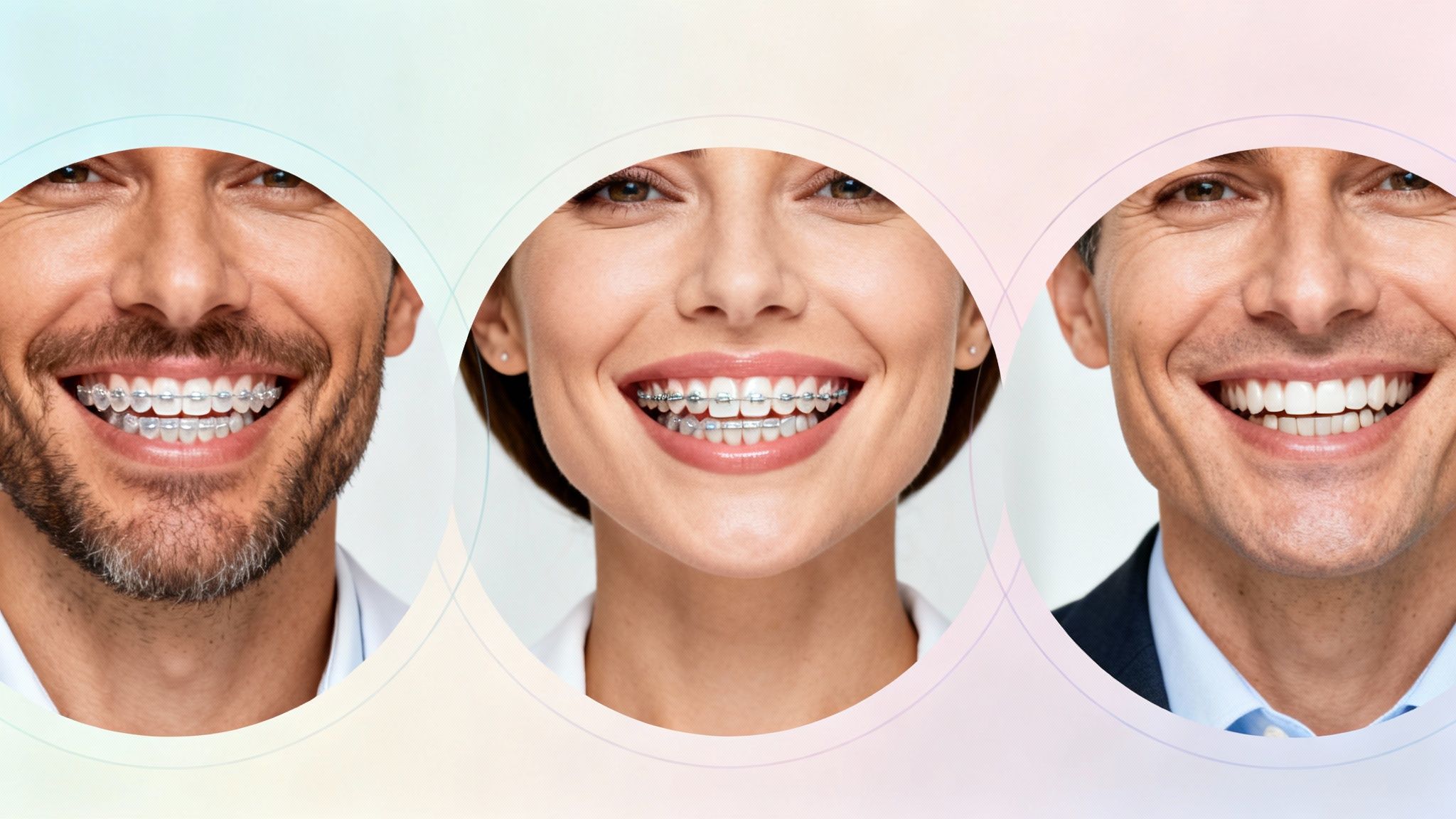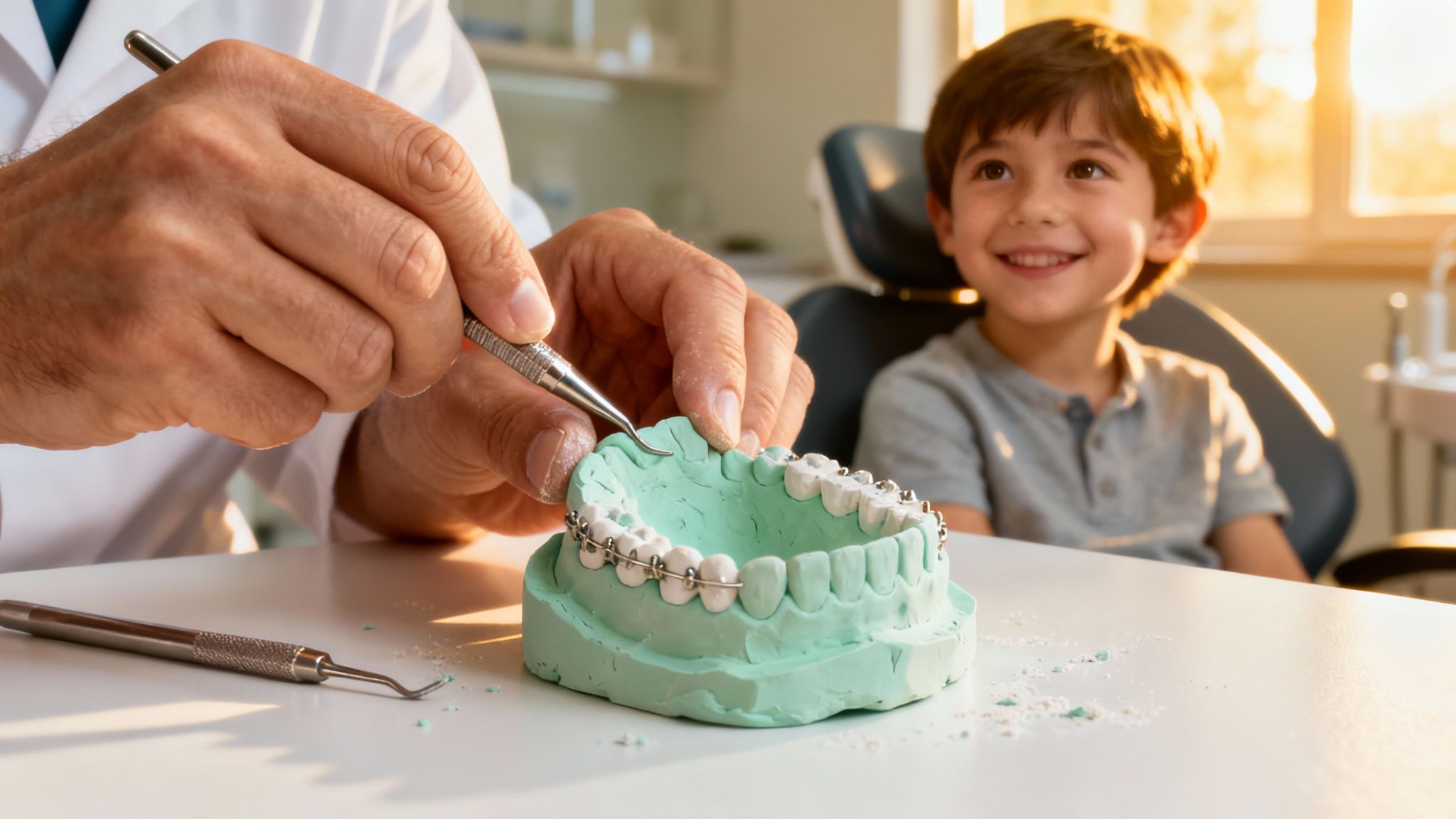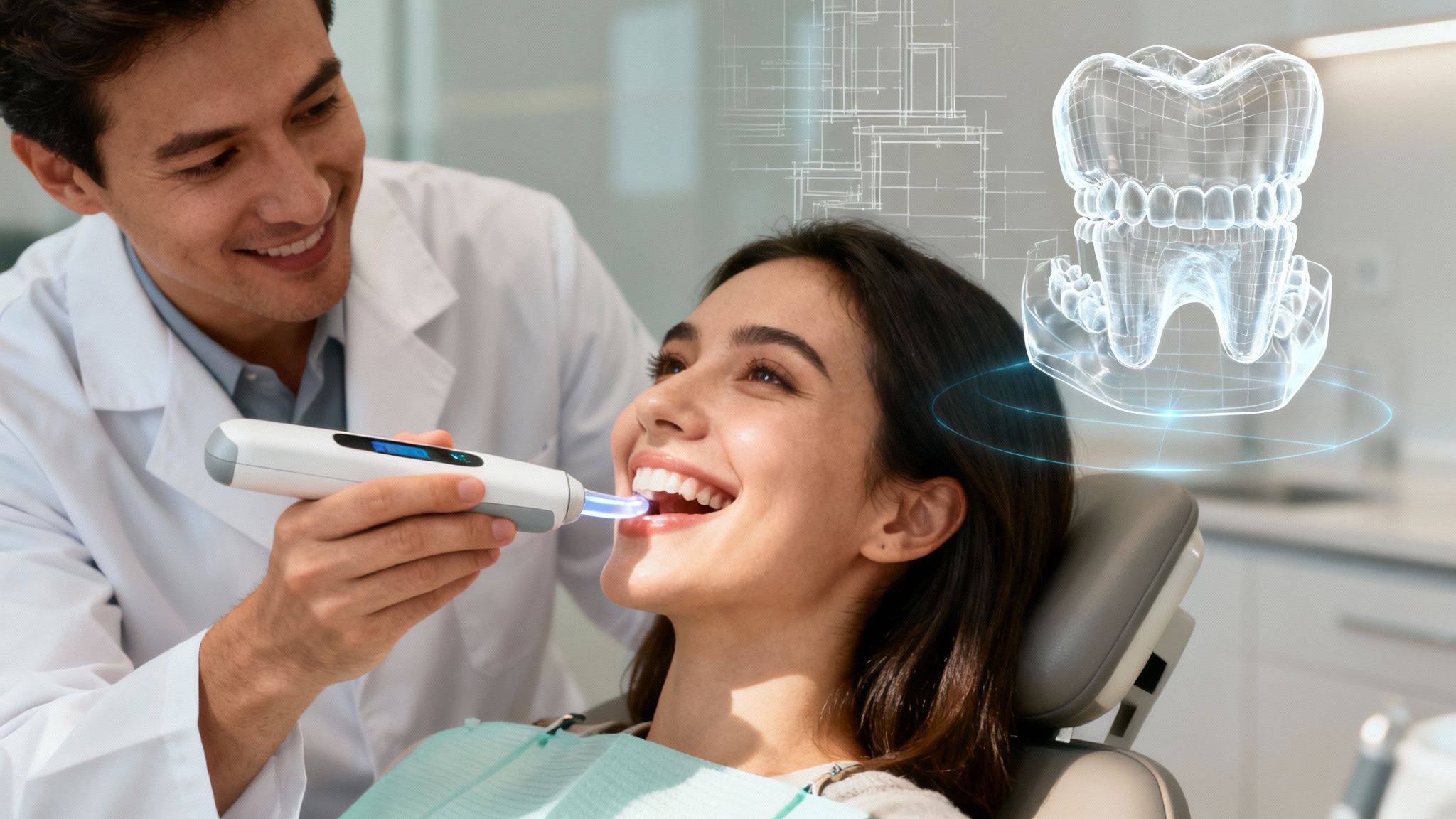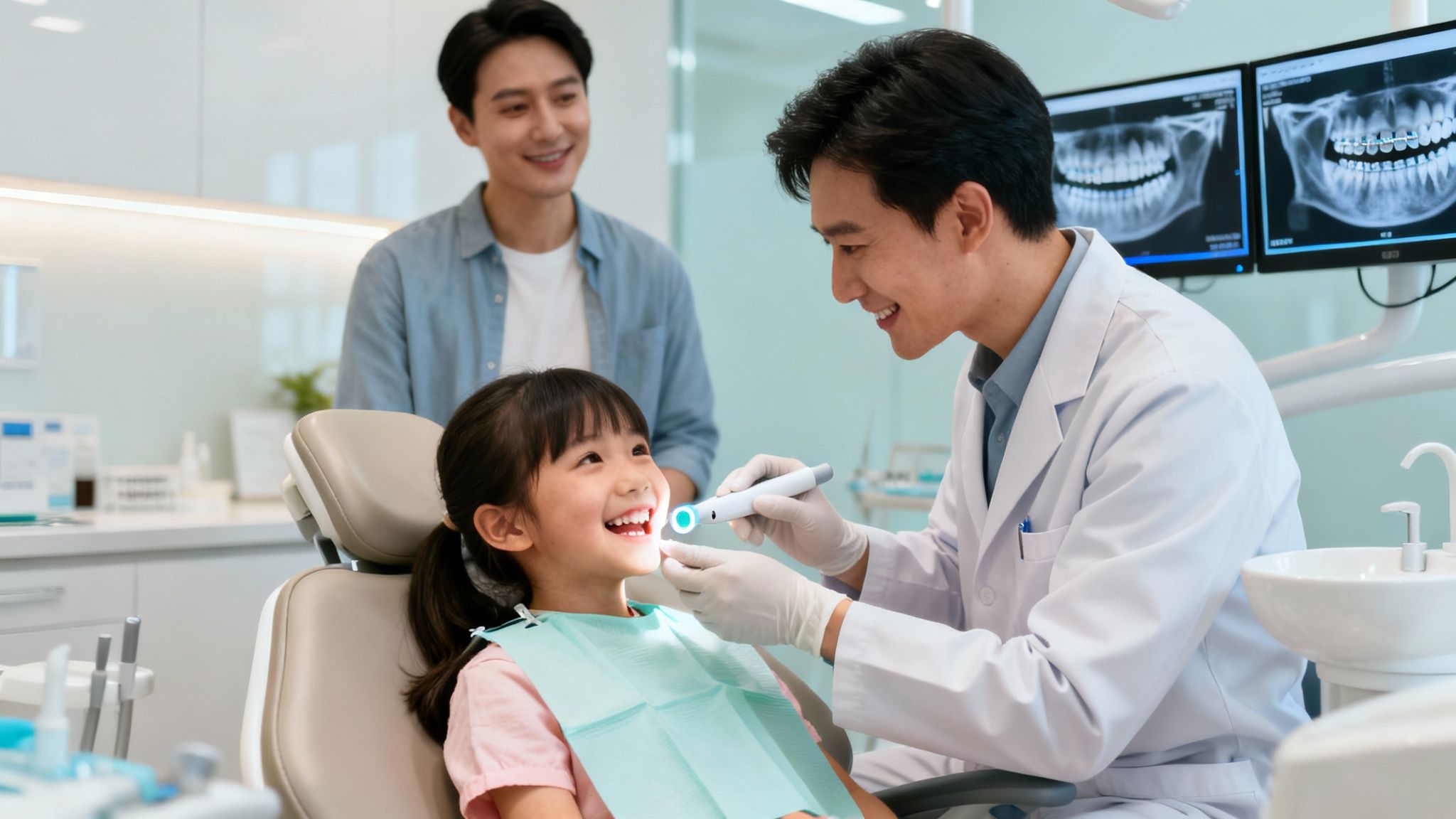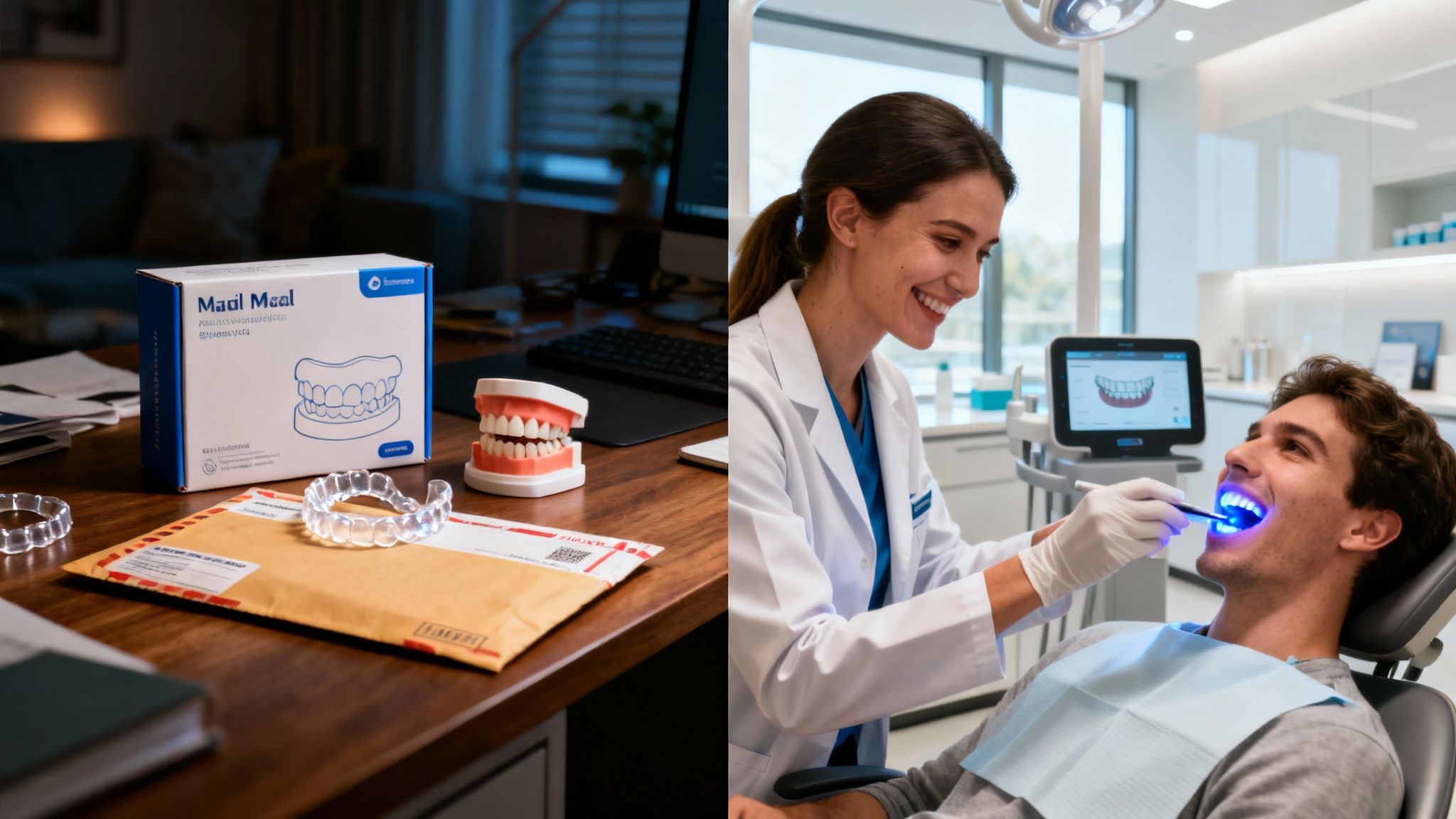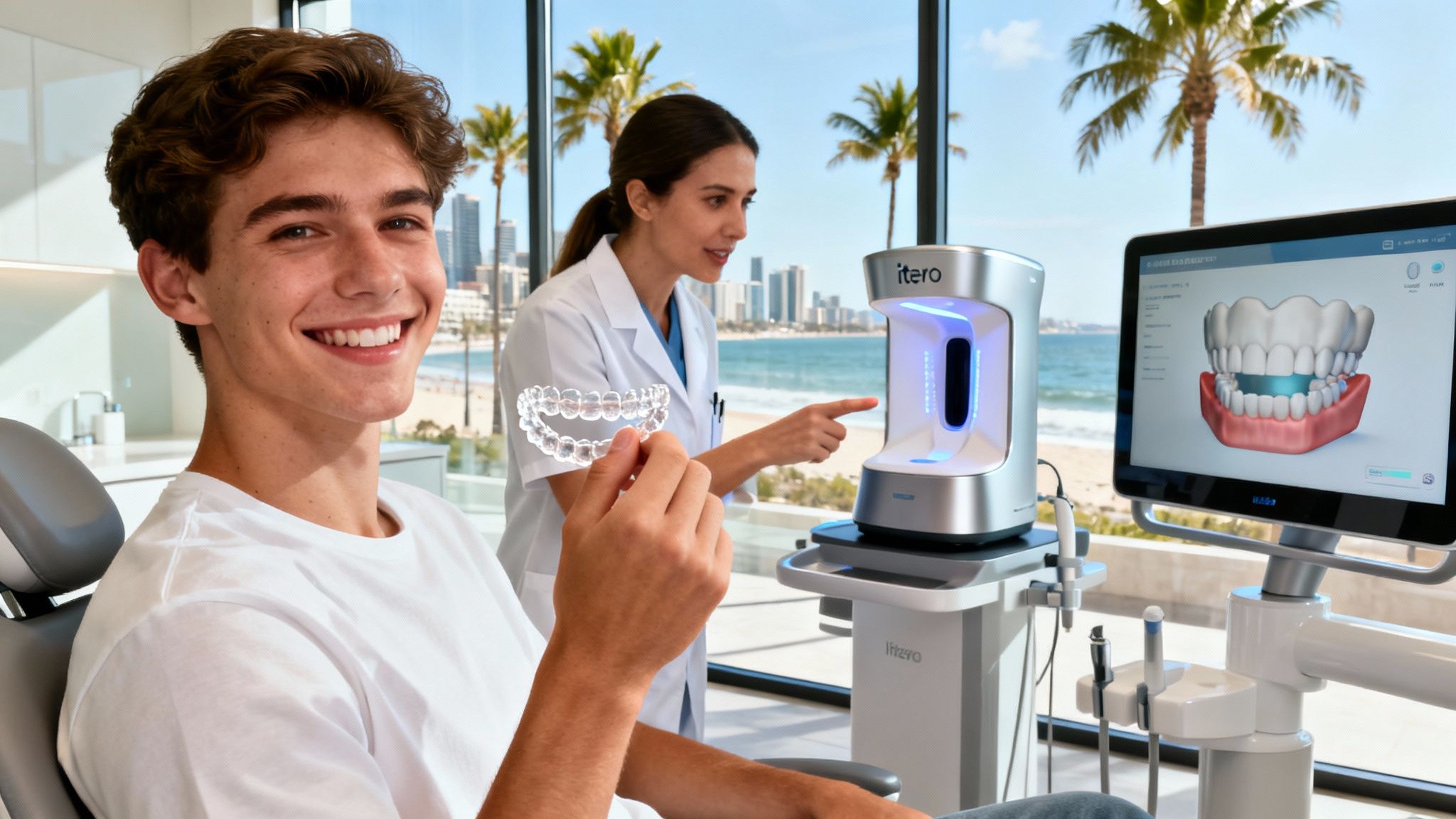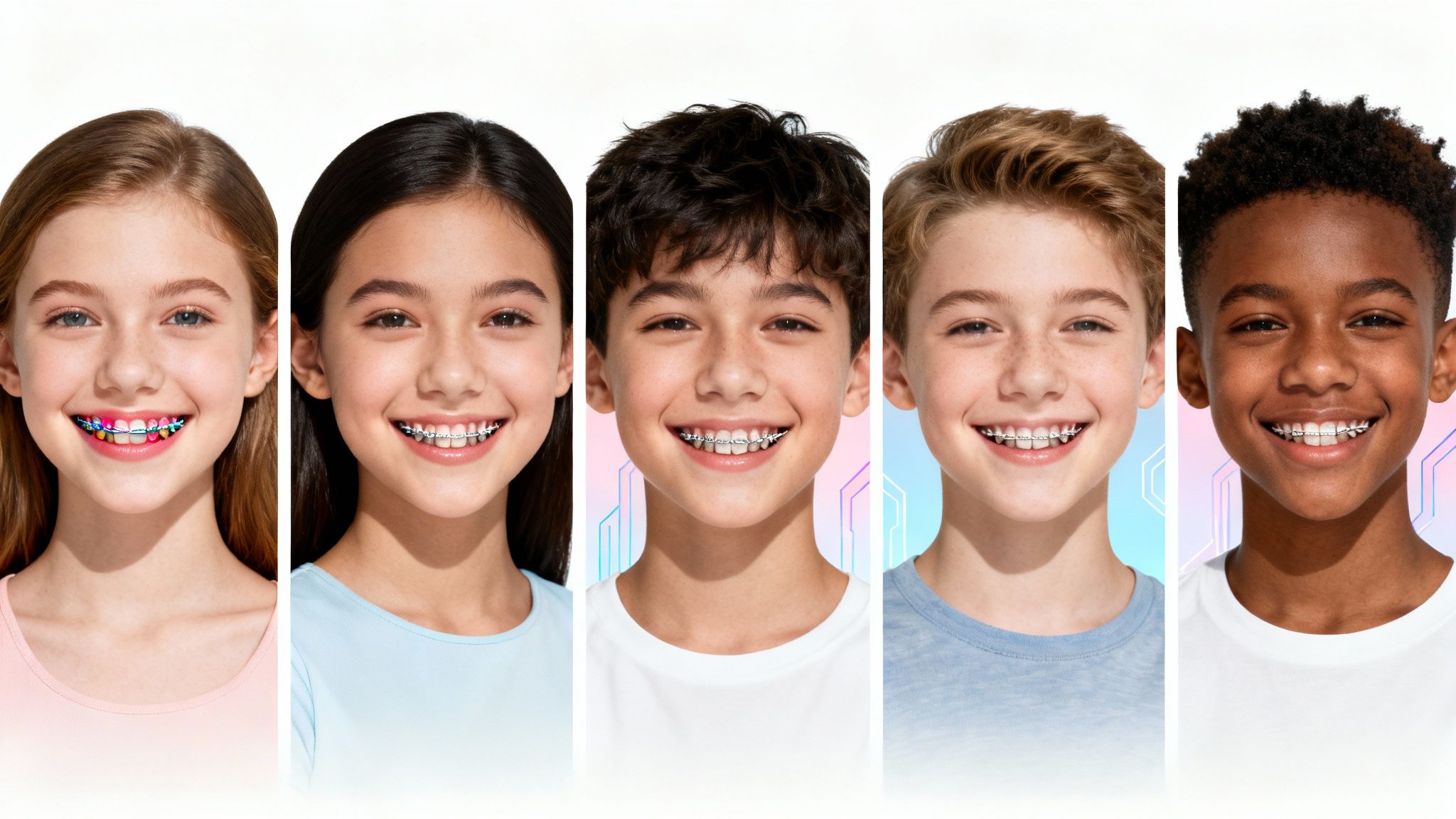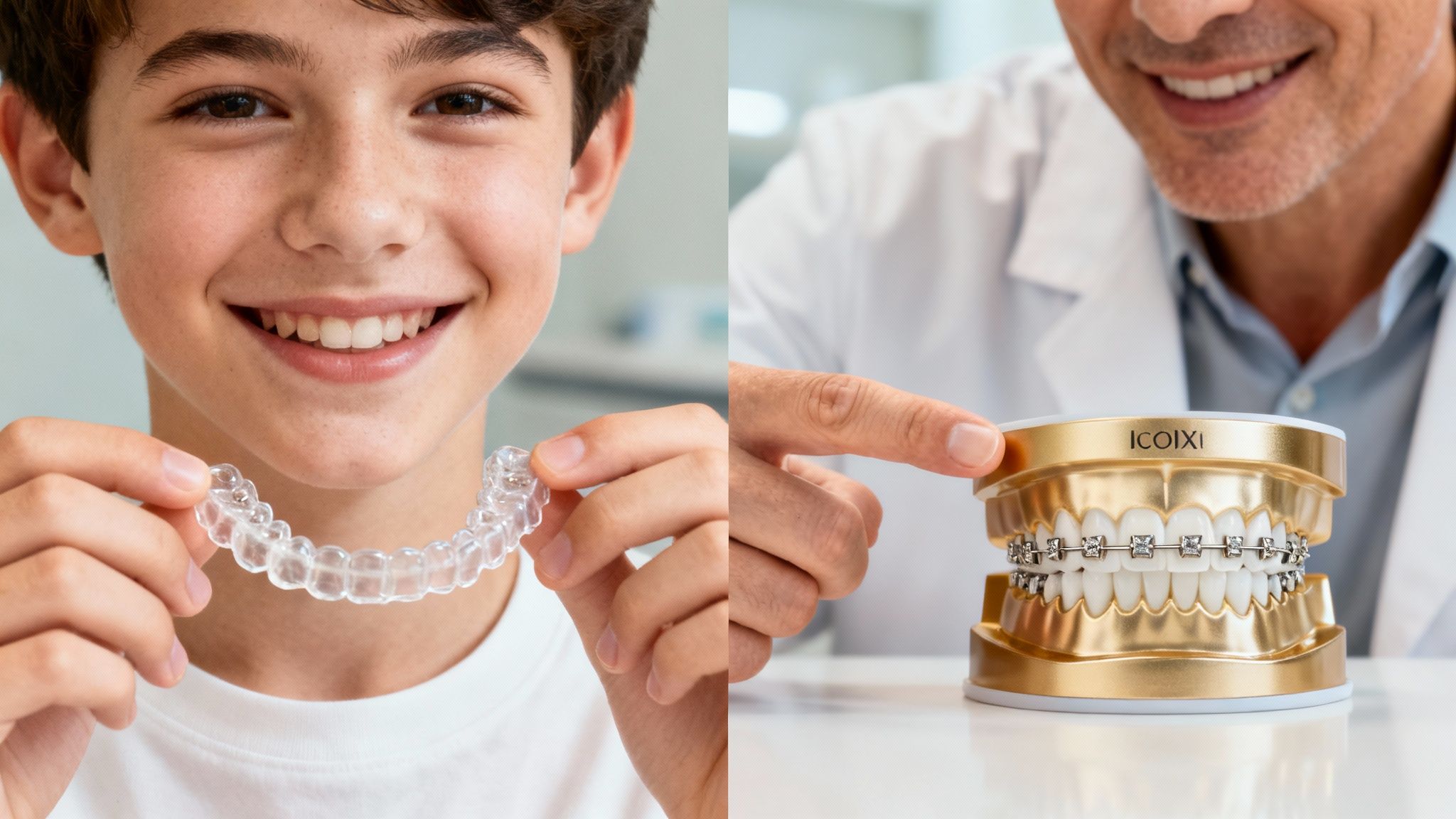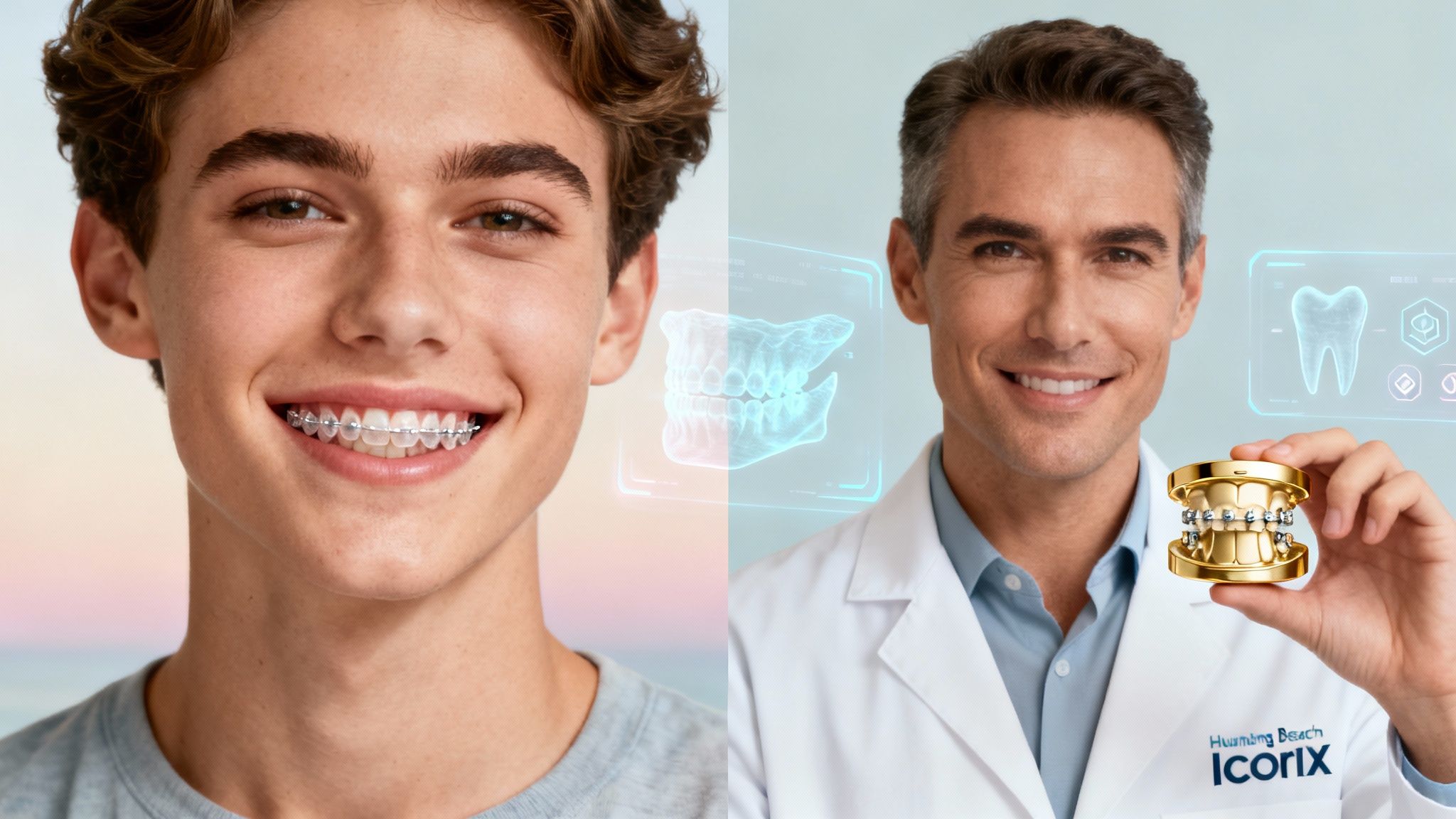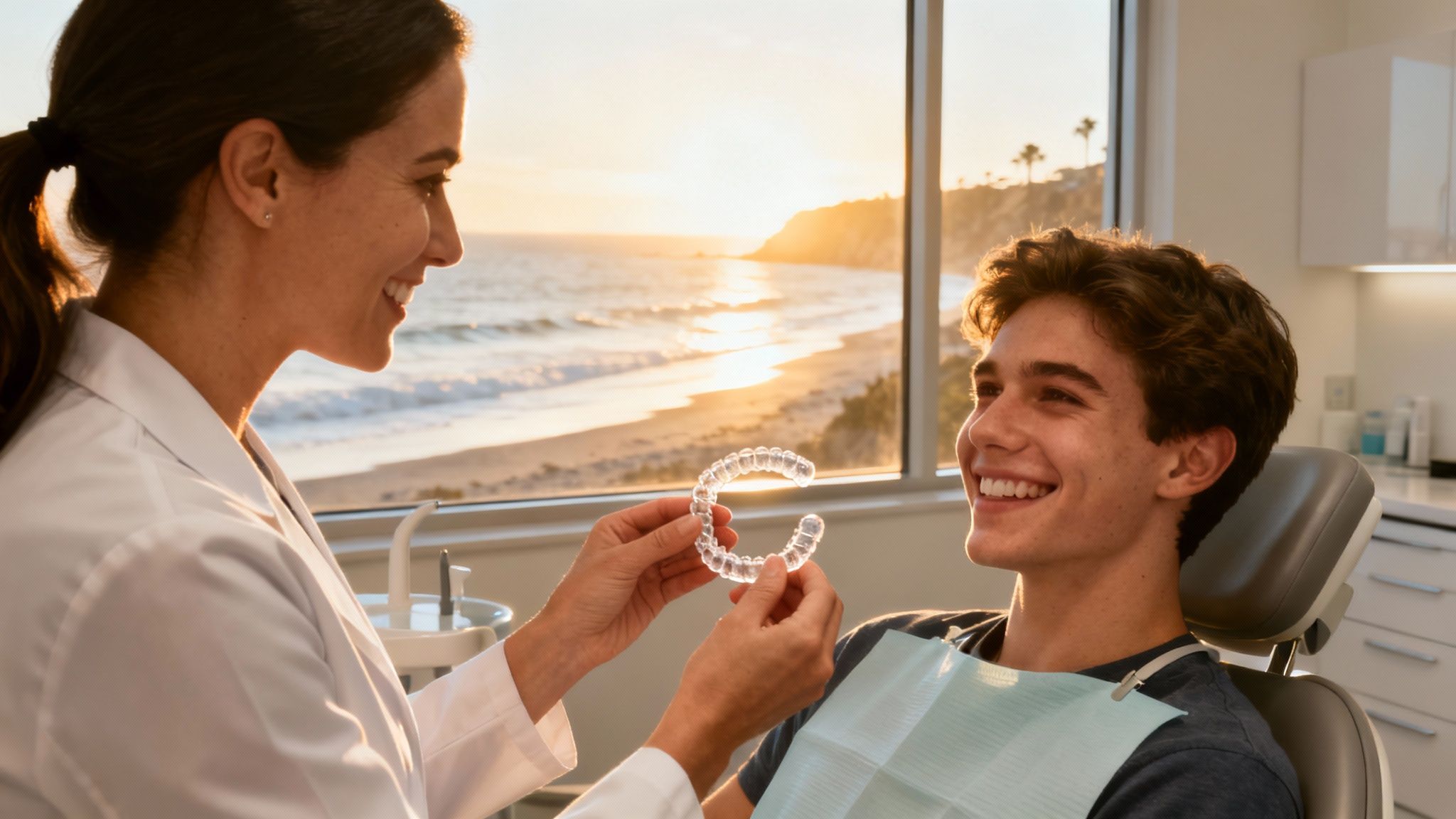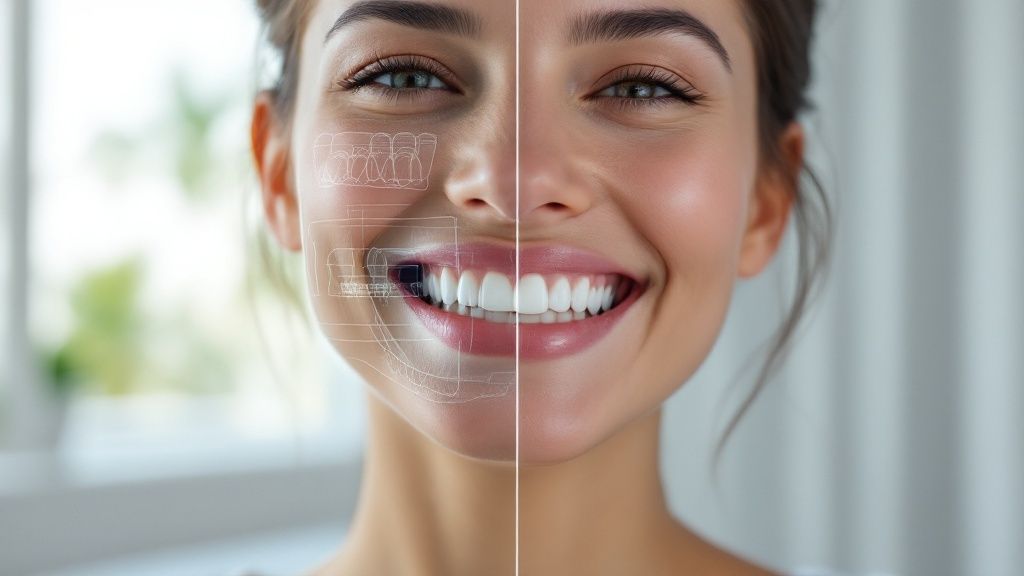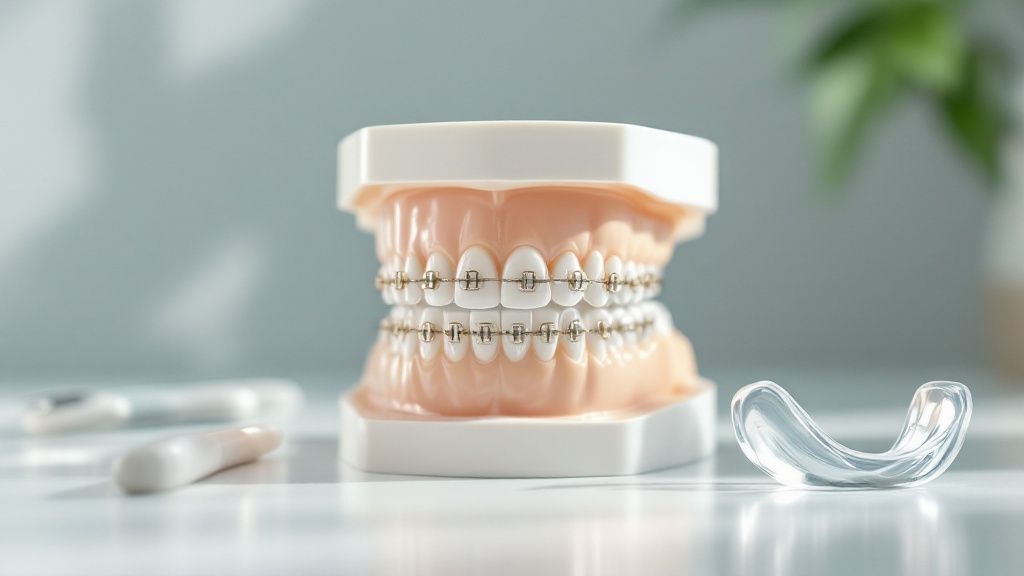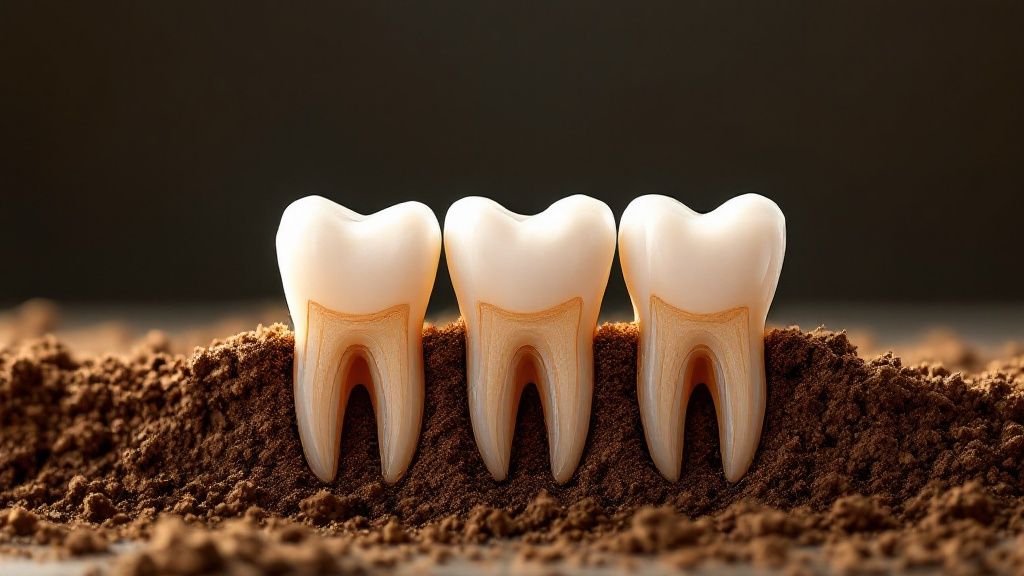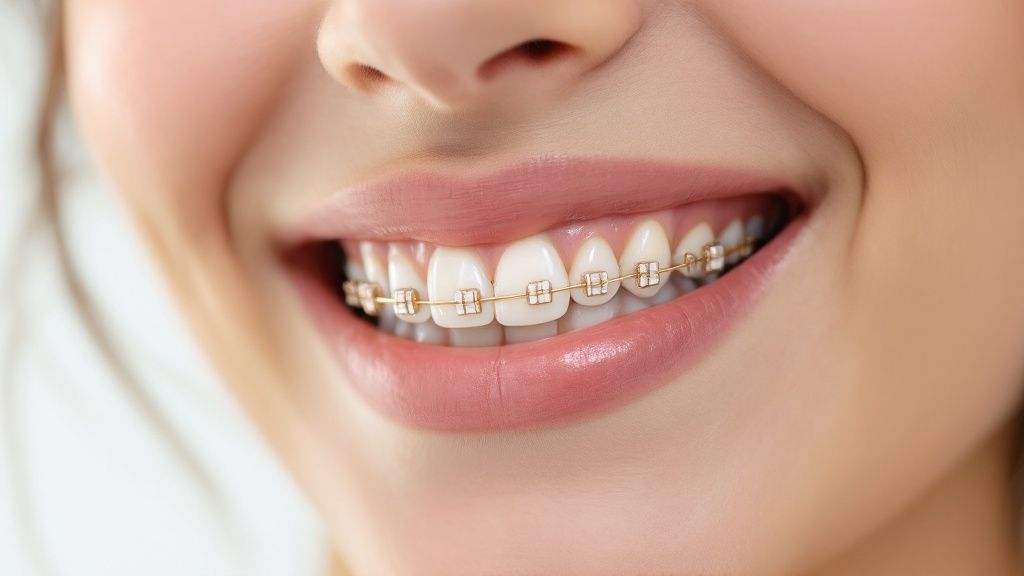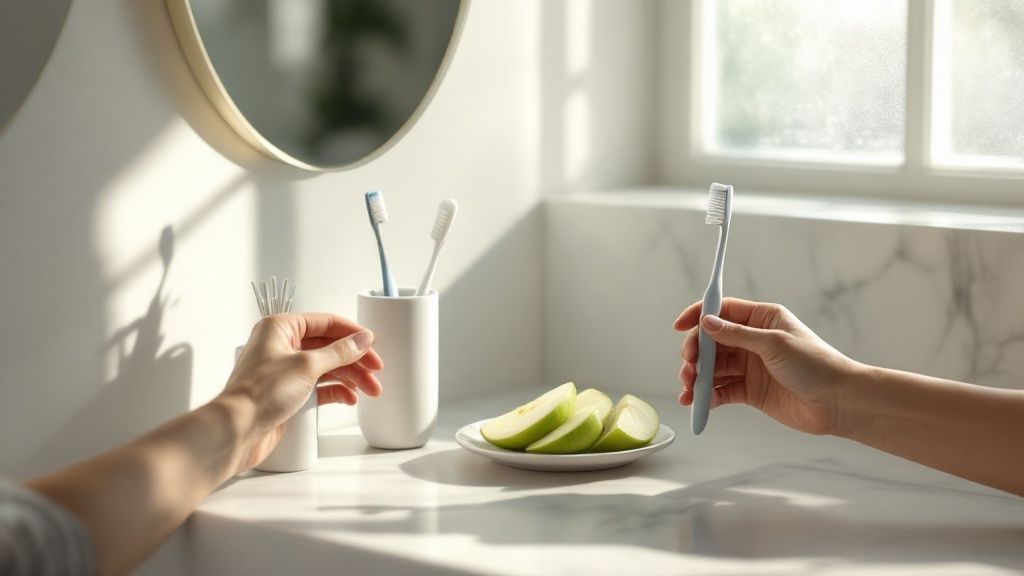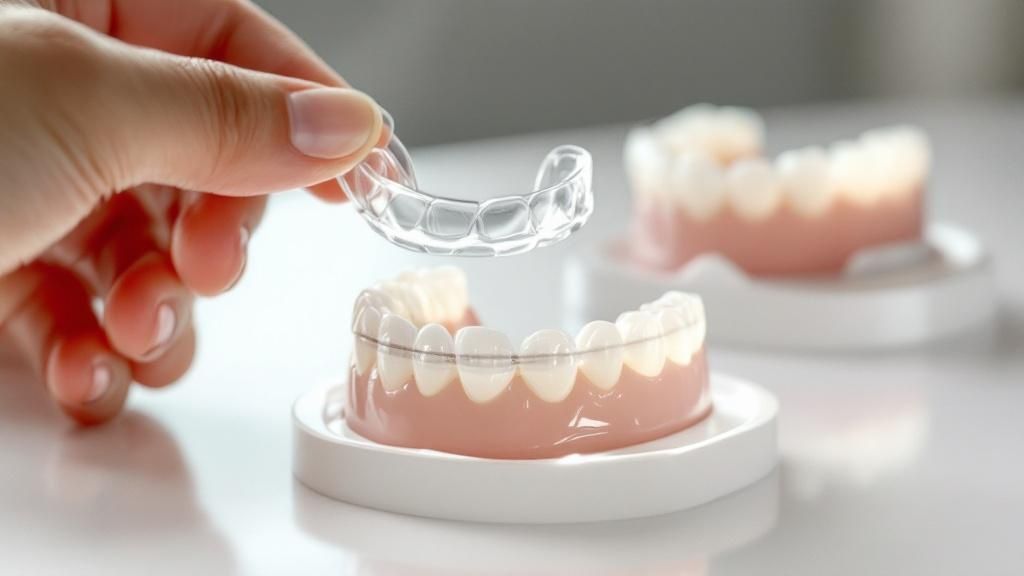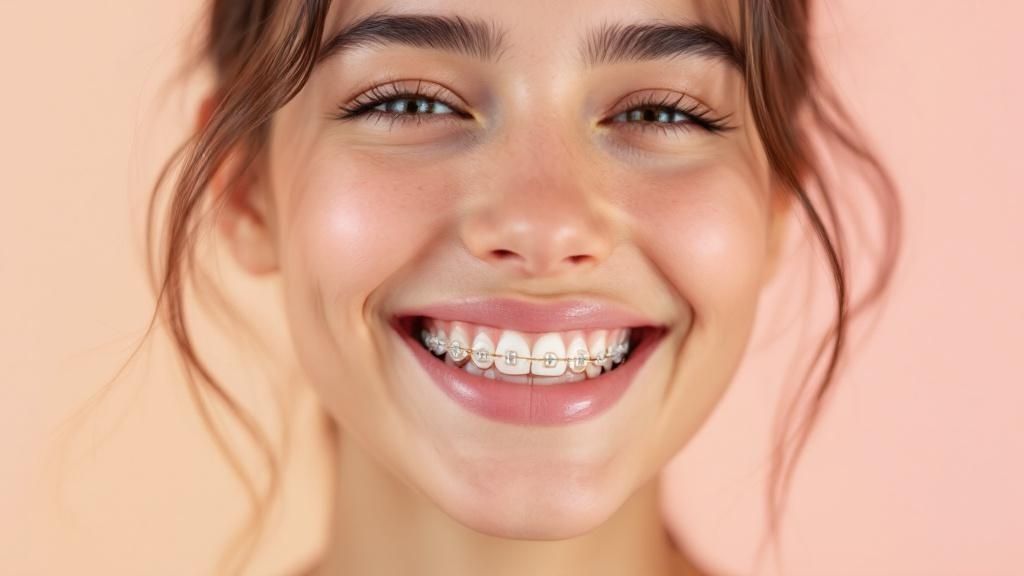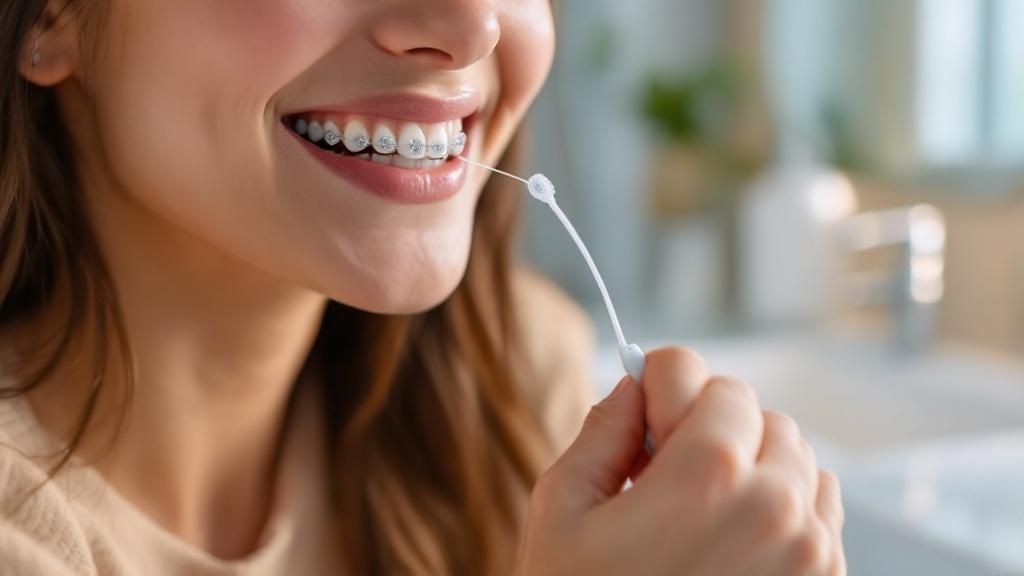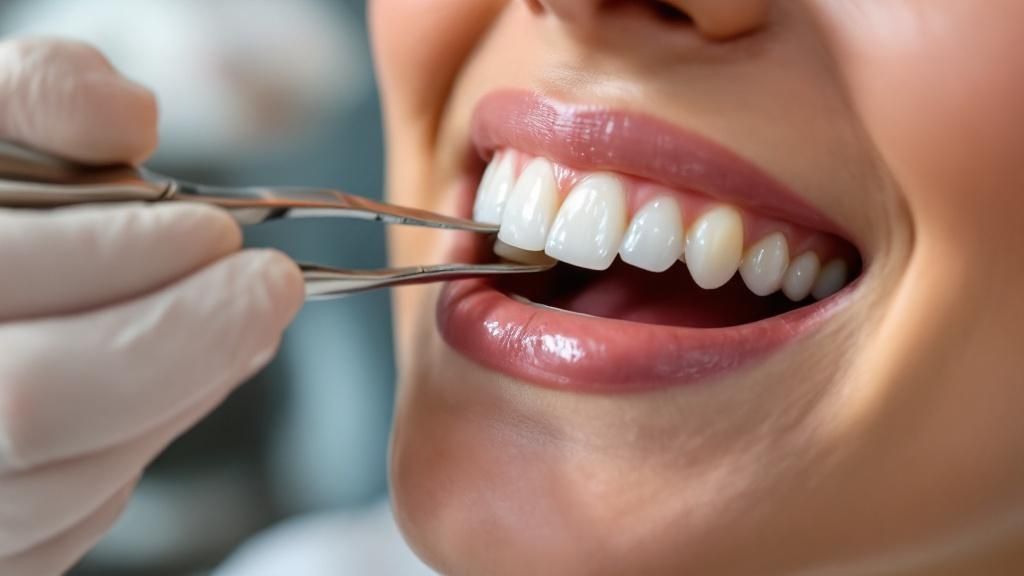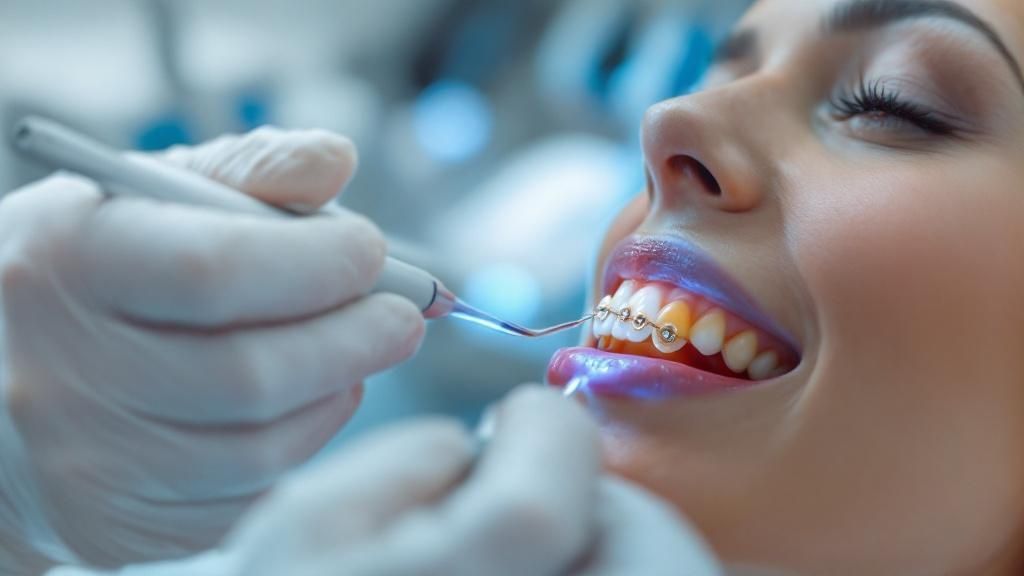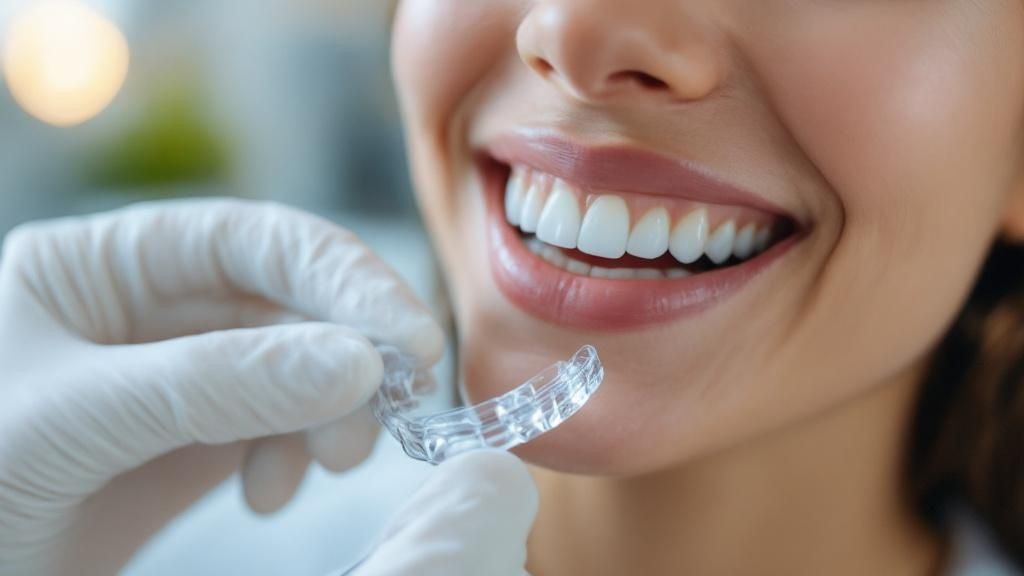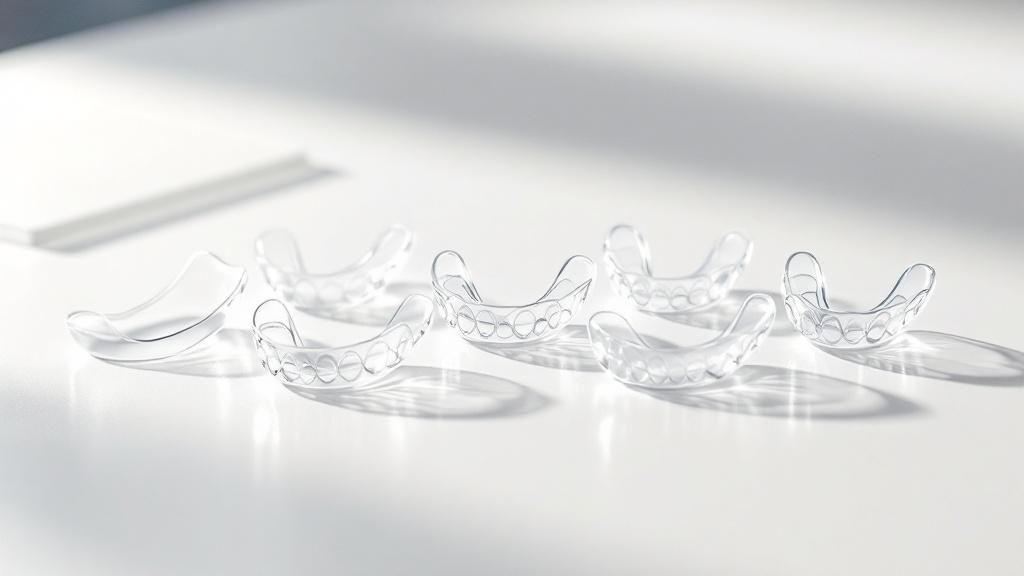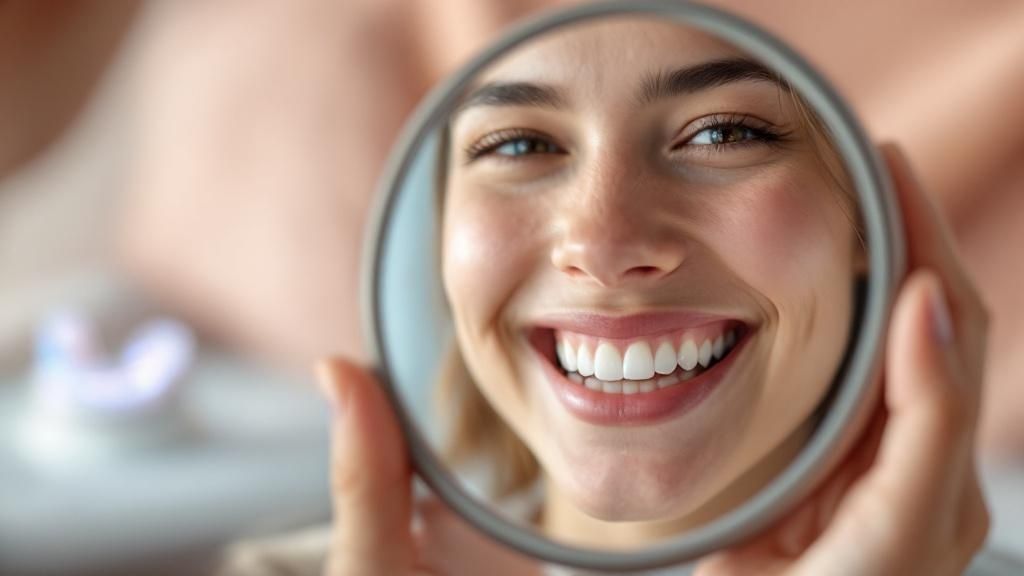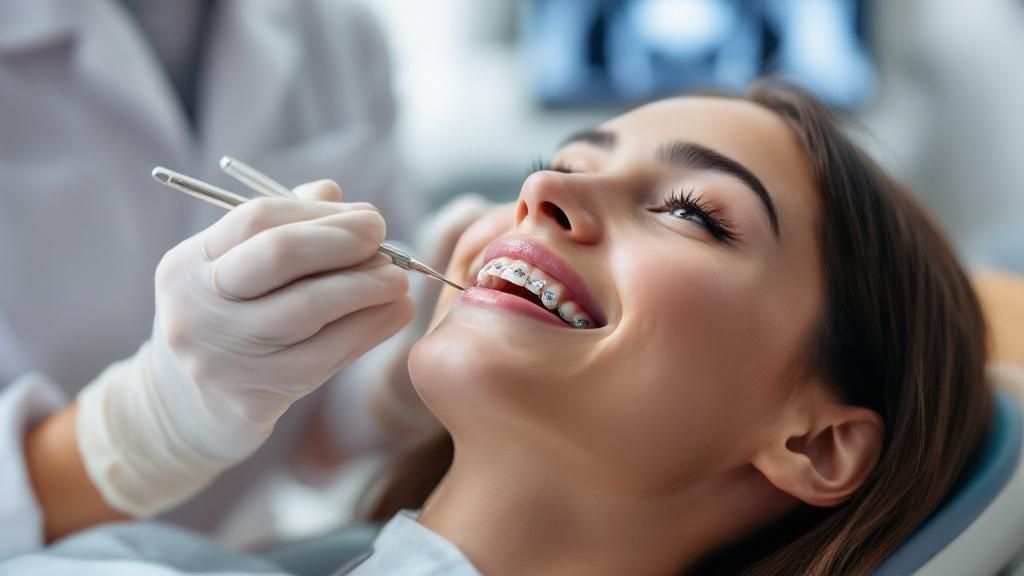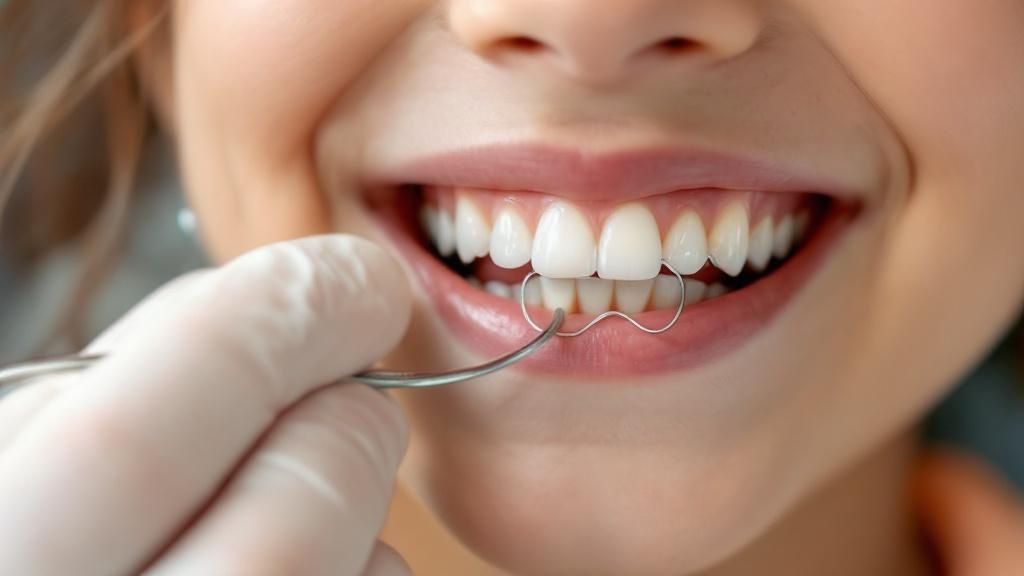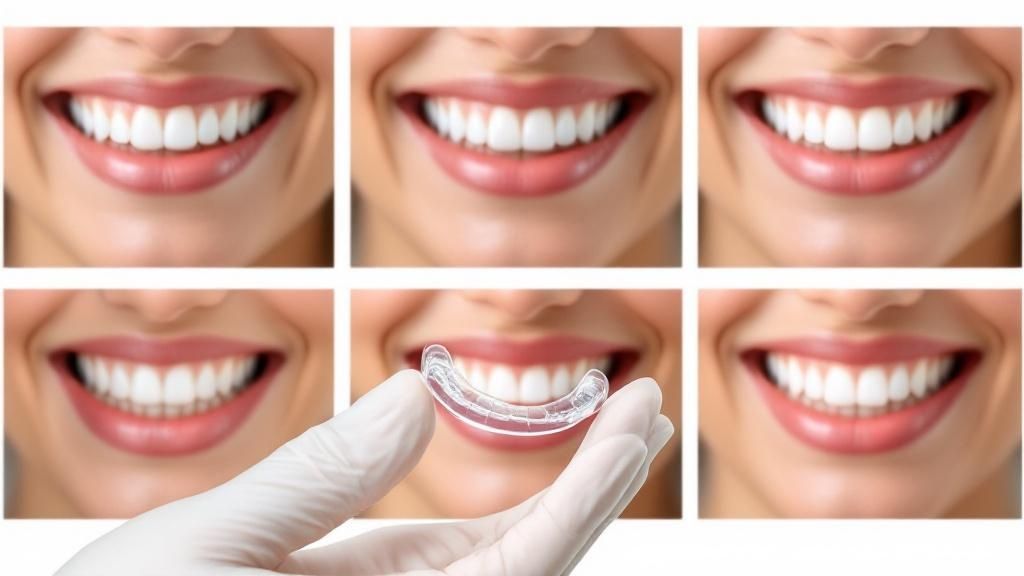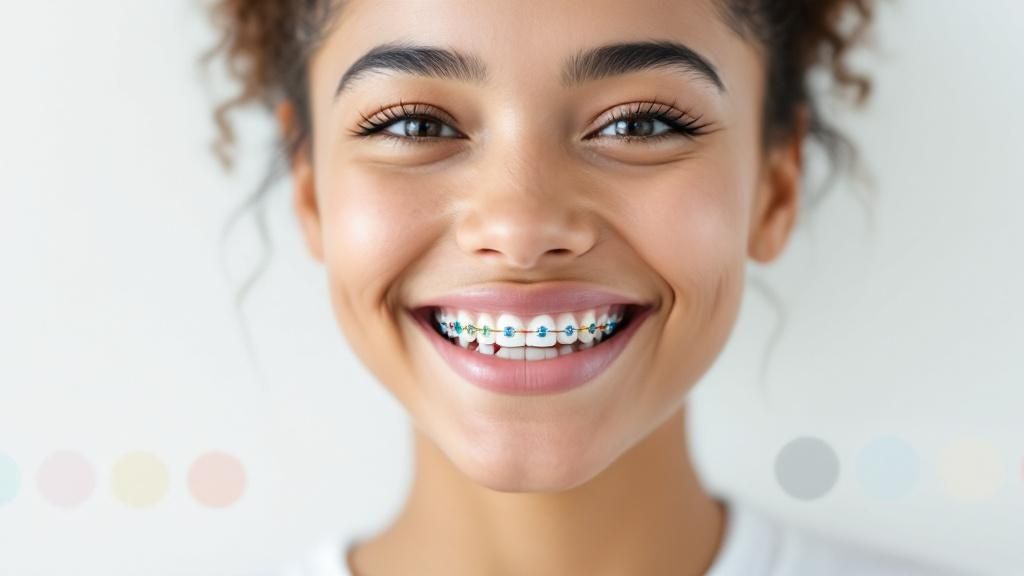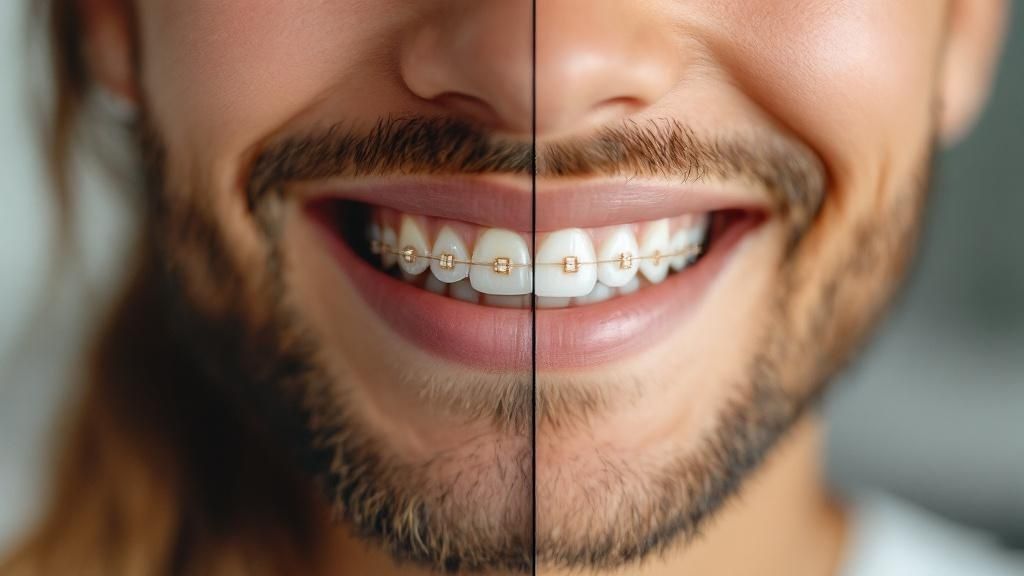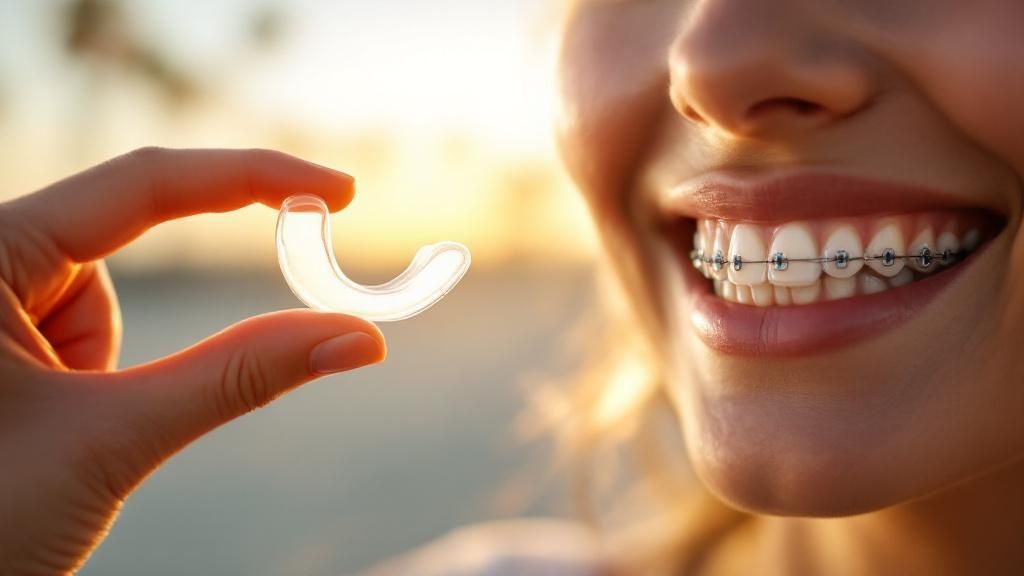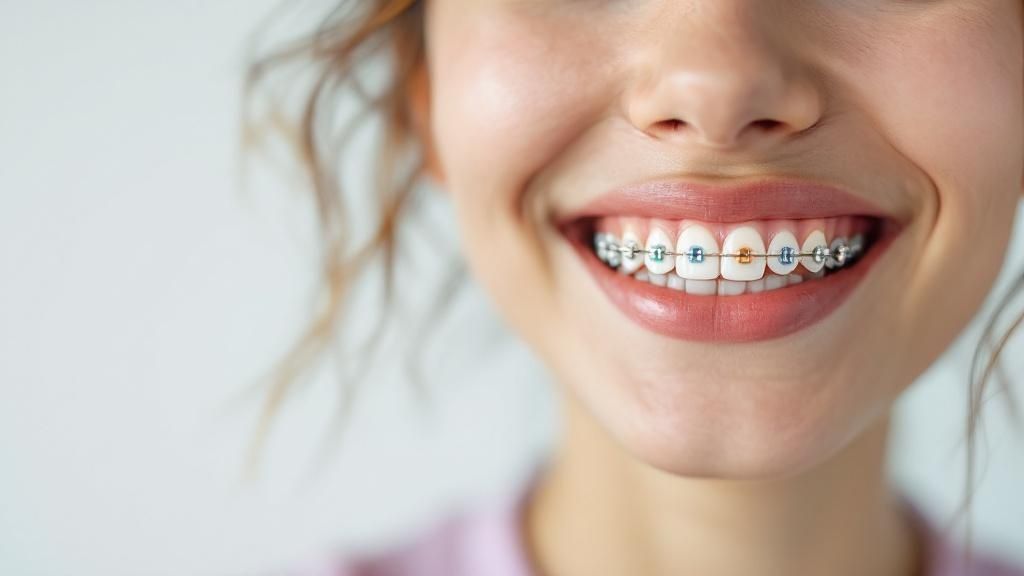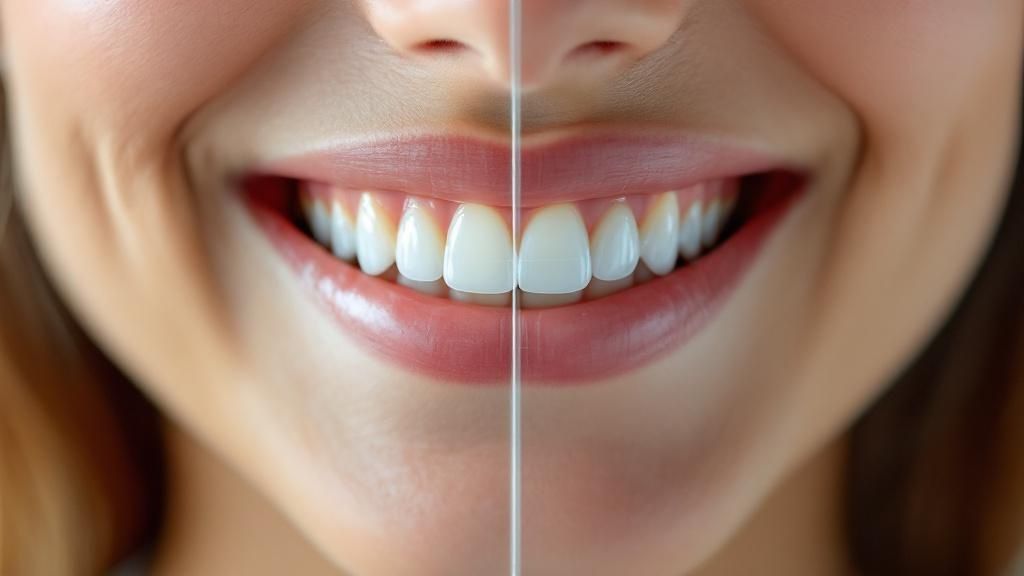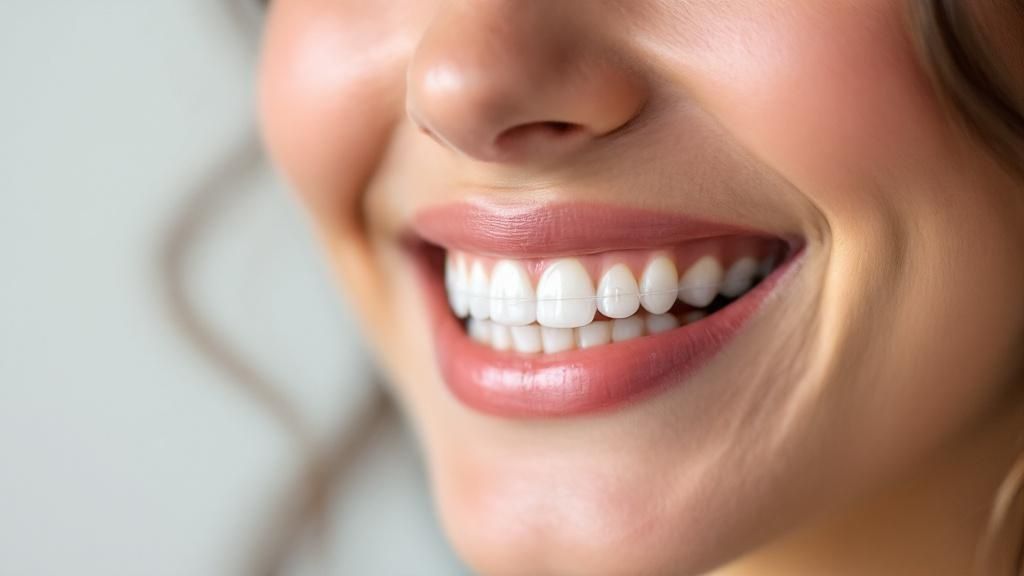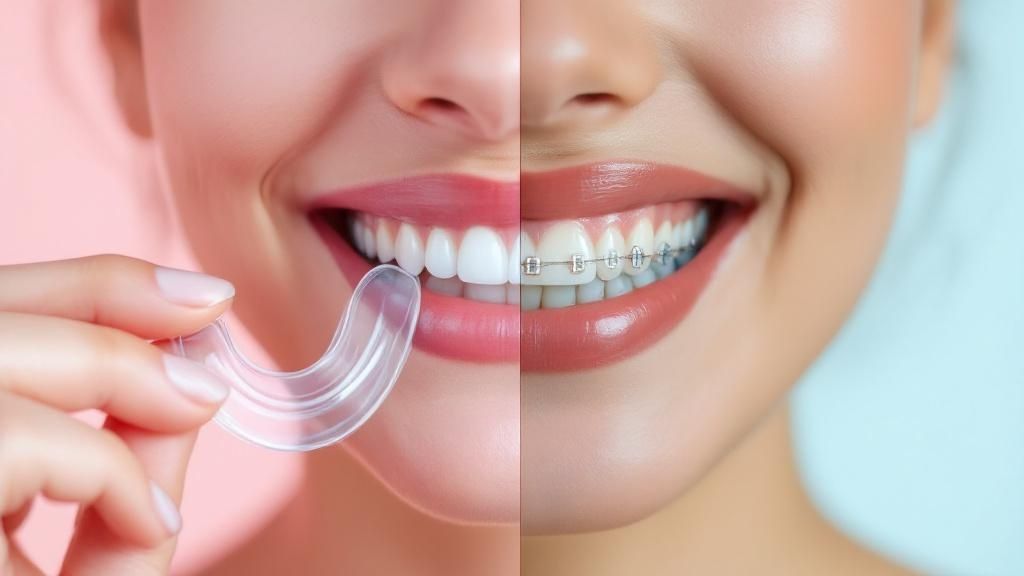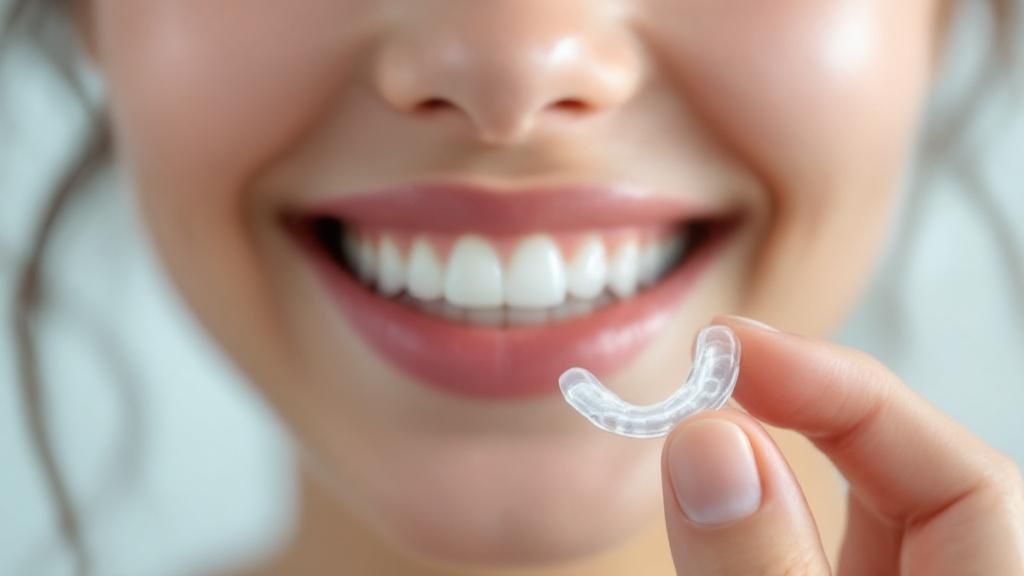
Teeth Shifted After Braces? Here’s How to Fix It
You invested time, effort, and excitement into achieving a perfectly straight smile. So, when you notice one of your teeth shifted after braces, it can feel incredibly discouraging.
Let's get one thing straight: a tiny bit of movement, or "settling," is a normal part of the process. It’s common, and most importantly, it’s fixable.
Why Your Smile Changes After Braces
After months or years of dedication, your braces come off, and your smile looks incredible. But then, you spot a subtle shift—a tiny gap or a tooth that’s not quite as straight as it was.
This is known as orthodontic relapse, and we see it often with patients from Huntington Beach and nearby communities like Fountain Valley. It’s not a sign that your treatment failed; it’s just biology at work.
Think of it this way: your teeth are held in place by periodontal ligaments, which are like tiny, stretchy rubber bands. After we remove the constant pressure from your braces, these ligaments have a "memory" and naturally want to pull your teeth back toward their old positions. This is the #1 reason why wearing your retainer consistently is non-negotiable.
Common Reasons for Post-Braces Movement
A few different things can cause your teeth to drift out of alignment. Understanding them is the first step in keeping your smile exactly where you want it.
- Natural Settling: Right after your braces are off, your teeth and the surrounding bone are still firming up. Minor movements are just part of this stabilization phase.
- Inconsistent Retainer Wear: This is the biggest reason we see for significant shifting. Your retainer is your smile's best friend, holding everything in place while the bone tissue hardens.
- Ongoing Growth: For our younger patients here in the Huntington Beach area, the jaw can continue to grow into the late teens or early twenties, which can impact alignment.
- Daily Habits: Things you might not even notice, like grinding your teeth at night (bruxism) or pressing your tongue against your teeth (tongue thrust), can exert enough force to push teeth out of place.
It's almost a given that teeth will try to move a little after orthodontic treatment. Research shows that once braces are removed, teeth have a natural tendency to relapse (Source: American Journal of Orthodontics and Dentofacial Orthopedics). How much they move varies, but it highlights why your retention plan is essential.
Quick Guide to Post-Braces Tooth Movement
Seeing a change can be frustrating, but the solution is often straightforward.
The same care you put into your oral hygiene with braces is just as critical now. Healthy gums and bone provide the strong foundation your newly straightened teeth need. For a quick refresher, you can check out our guide on how to care for braces.
Don't panic if you see a shift. We can quickly get to the bottom of it and map out a simple plan to guide your smile back to where it belongs.
Understanding Why Teeth Move Back
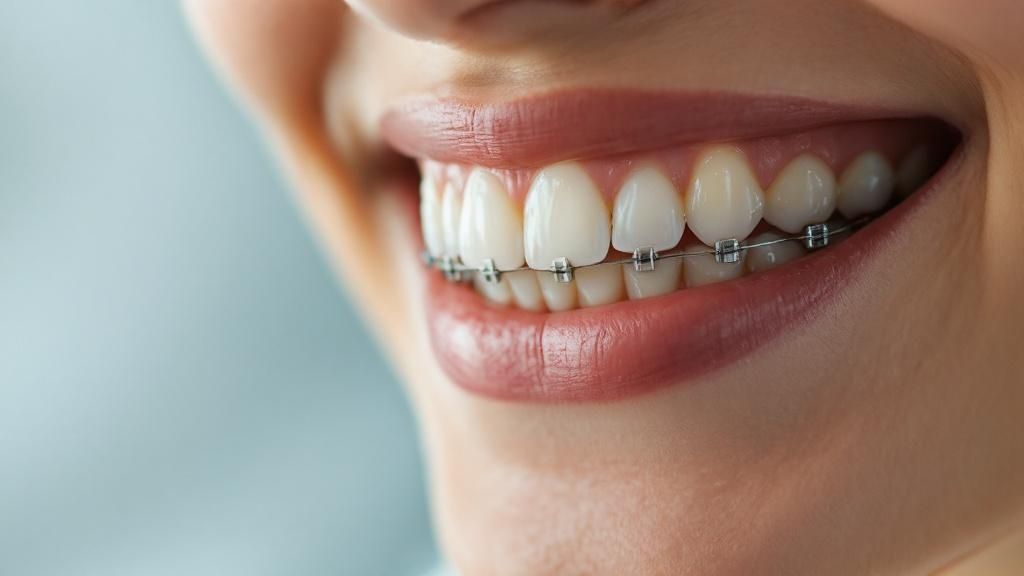
So, you went through the whole process, and now you're wondering, "Why are my teeth moving back?" It’s a common frustration with a good reason: cellular memory.
Your teeth aren’t just locked into your jawbone. They're held in place by a network of tiny, elastic tissues called periodontal ligaments. For months, these ligaments have been stretched into a new position.
Once the braces come off, their natural tendency is to spring back to where they started. This is what orthodontists call an orthodontic relapse. This gentle but constant pulling is exactly what your retainer is designed to fight against.
The Role of Natural Growth and Daily Habits
It's not just about your ligaments playing tug-of-war. A few other factors are constantly at work, and understanding them is key to keeping your smile looking great.
Jaw development is a big one, especially for patients in their late teens or early twenties. Even after your orthodontic treatment is "done," your jaw can continue to grow and subtly change shape, altering the very foundation supporting your teeth. An experienced orthodontist knows to plan for these changes. For more on this, check out our guide on how to choose an orthodontist who prioritizes long-term stability.
Unconscious Pressures on Your Smile
Beyond natural shifts, some of our own habits can actively push against that beautifully aligned smile. Most of the time, you don't even realize you're doing it.
Here are a few common culprits we see at our Huntington Beach practice:
- Bruxism (Teeth Grinding): Many people grind their teeth at night without a clue. This heavy pressure can easily nudge teeth out of place.
- Tongue Thrust: This is a habit where you push your tongue against your front teeth when you swallow. That repetitive pressure can eventually create gaps or cause front teeth to flare out.
- Nail Biting or Chewing on Pens: Any habit that puts consistent, odd pressure on your teeth can contribute to shifting over time.
These habits can be sneaky. For instance, understanding the dangers of grinding your teeth while you sleep can be an eye-opener if you've noticed alignment changes despite wearing your retainer. Our team at Magic Fox Orthodontics is here to help you pinpoint these hidden causes.
Your Retainer Is Your Smile's Best Friend

Think of your retainer as an insurance policy for your smile. After dedicating months or years to orthodontic treatment, this simple device is what prevents your teeth from shifting back.
A retainer's job is to hold your teeth in their new positions while the surrounding bone and ligaments stabilize. Without that support, natural forces will start pulling your teeth back toward their old alignment. This is why wearing your retainer as directed is non-negotiable. If you want to dive deeper, there's a great breakdown of what a retainer does and why it's so important.
Choosing the Right Retainer for Your Lifestyle
At Magic Fox Orthodontics, we know the best retainer is the one you’ll actually wear. That’s why we offer different options for our patients across Huntington Beach and Fountain Valley.
- Removable Clear Retainers: These look like Invisalign aligners and are custom-molded to fit perfectly over your teeth. You can pop them out for eating and cleaning, making them a popular choice.
- Bonded (Fixed) Retainers: This is a thin, medical-grade wire we permanently bond to the back of your front teeth. It offers 24/7 protection against shifting without you having to think about it.
Choosing your retainer type is a big decision. Research confirms that the type of retention significantly impacts whether your teeth will shift. While bonded retainers are amazing for lower front teeth, some people prefer the ease of a removable one. No matter which you choose, neglecting it can lead to relapse for over 70% of patients (Source: American Association of Orthodontists).
Frequently Asked Questions About Retainers
It’s normal to have questions as you move into this new phase. Here are some we hear from our patients, whether they're from Goldenwest or Oak View.
How long do I really need to wear my retainer?
Right after treatment, we recommend full-time wear for a few months. After that, you’ll likely graduate to wearing it only at night. For results that last a lifetime, nighttime wear should become a permanent part of your routine.
Your teeth can shift throughout your entire life, not just in the months after braces. Lifelong nighttime retainer wear is the only way to guarantee your smile stays perfectly straight forever.
What if I forget to wear it for a night?
Forgetting for one night isn't usually a catastrophe. But if you skip several nights, you'll probably notice your retainer feels extra tight. That's a sure sign your teeth have shifted after braces.
How can I tell if my retainer fits right?
A properly fitting retainer should feel snug but not painful. If you have to force it into place or it's causing real discomfort, your teeth have likely moved. Do not force it. Instead, call us at Magic Fox Orthodontics right away.
Modern Fixes For Teeth That Have Shifted
If you’ve noticed your teeth have shifted after braces, take a deep breath. It's disheartening, but the good news is that we have fantastic ways to correct it—often much faster than your original treatment.
Modern orthodontics offers discreet, efficient ways to guide your teeth back into place. At Magic Fox Orthodontics, we specialize in these minimally invasive solutions for orthodontic relapse. For many of our patients here in Huntington Beach, a short "touch-up" treatment is the perfect fix.
Invisalign Touch-Ups: A Discreet And Fast Solution
Imagine a patient from the Wintersburg neighborhood comes to see us. They had braces as a teen, but years later, they’re noticing a small gap opening up. A brief course of Invisalign can close that gap in just a few months.
This approach is incredibly popular for a few key reasons:
- It’s Discreet: The clear aligners are practically invisible, so you can straighten your smile without anyone knowing.
- It’s Convenient: You can take the aligners out to eat, drink, and brush your teeth normally.
- It’s Fast: Correcting minor relapse often takes significantly less time, sometimes as little as 3 to 6 months.
This targeted treatment focuses only on the teeth that have moved, making it an efficient and affordable option. You can learn more about how Invisalign can revolutionize your smile in 5 easy steps in our detailed guide.
When A New Retainer Is The Answer
Sometimes, the solution is even simpler. If we catch the shifting very early, a new, perfectly-fitting retainer might be all you need to stop further movement.
Another great option we might discuss is a bonded retainer. This is a thin wire permanently attached to the back of your front teeth, giving you constant, invisible protection. It’s an excellent choice for anyone prone to relapse or who worries about forgetting a removable retainer.
The key is to act quickly. The sooner you come in to address any shifting, the easier and more affordable the solution will be. Don't wait for a small problem to become a bigger one.
This visual shows the standard retention plan we recommend to all our patients.

As you can see, your commitment to wearing your retainer changes over time, but it never really ends. Think of it as a lifelong protector for your smile.
Protecting Your Smile for the Long Haul
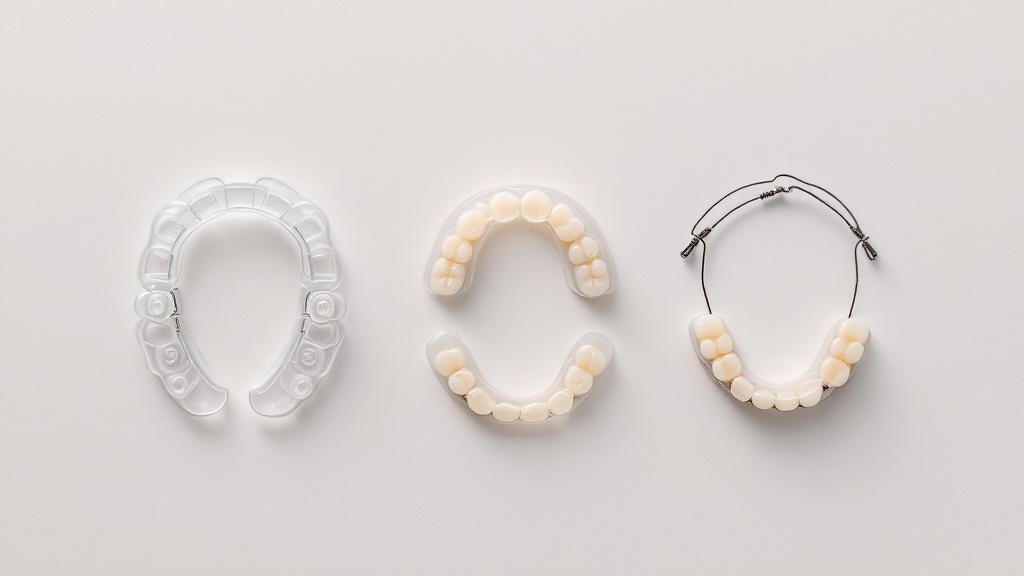
That incredible, straight smile you worked so hard for is an investment that deserves to be protected. Keeping the amazing results you achieved at Magic Fox Orthodontics requires a little ongoing effort.
It's about more than just remembering your retainer. Protecting your smile means being mindful of your daily habits and overall oral health.
Creating a Proactive Smile Protection Plan
Think of maintaining your results as an active process. We want to be your long-term partners in keeping that smile healthy and straight for life.
Here's a quick checklist to help protect your investment:
- Master Your Retainer Care: Keep your retainer clean by gently brushing it daily with a soft-bristled toothbrush and cool water. Always store it in its case.
- Address Harmful Habits: Try to consciously stop behaviors like biting your nails or chewing on pen caps. These habits can exert enough force to cause teeth to shift after braces.
- Prioritize Periodontal Health: Healthy gums are the foundation holding your teeth firmly in place. Diligent brushing, flossing, and regular dental cleanings are non-negotiable.
The Importance of Ongoing Check-Ups
Even after your main orthodontic treatment is done, popping in for periodic check-ups is a fantastic idea. These visits let us inspect your retainer, check your alignment, and catch tiny issues before they become bigger problems.
A common misconception is that once your braces are off, your orthodontic journey is over. In reality, the retention phase is a lifelong commitment to preserving your smile.
We can also keep an eye out for things like nighttime teeth grinding (bruxism). And if you're thinking about making that new smile even brighter, you might want to look into professional teeth whitening services to really make it pop.
Our goal is to offer continuous support for all our patients, from Huntington Beach to Fountain Valley. By working together, we can make sure the smile you invested in lasts a lifetime.
Frequently Asked Questions About Post-Braces Shifting
We get it. After you put so much effort into getting a perfect smile, seeing your teeth move again can be disheartening. It’s one of the most common concerns we hear from our Huntington Beach patients.
Here are answers to questions that are likely on your mind.
Is it normal for teeth to shift a little after braces?
Yes, a tiny bit of movement, or "settling," is completely normal as your teeth and jaw find their final, comfortable resting place.
However, obvious changes—like a new gap or a twisted tooth—are a sign of orthodontic relapse. This is your cue to call our Huntington Beach office right away to stop it from getting worse.
How much does it cost to fix teeth that have shifted?
This really depends on how much your teeth have moved. For slight adjustments, a short series of Invisalign aligners or even just a new retainer might be all you need.
These options are much more affordable than a full new round of braces or Iconix esthetic brackets. To get a better idea of the numbers, check out our guide comparing Invisalign cost vs. braces cost. We’ll give you a clear, no-surprises cost at your free consultation.
Can I just wear my old retainer to move my teeth back?
Please don't force it! If your old retainer doesn't slide in easily, trying to jam it onto your teeth can put dangerous pressure on the roots and gums.
The safest move is to schedule a visit with us at our office at 17041 Beach Boulevard Suite 101, Huntington Beach, CA 92647. We can see if a new retainer or a quick touch-up treatment is the best way to get your teeth back where they belong.
How long will a touch-up treatment take?
You’ll be happy to hear that correcting a minor relapse is usually a quick process. For most patients, a simple touch-up with a few Invisalign aligners can get the job done in as little as 3 to 6 months.
It's a fantastic option for adults who want to restore their smile without committing to the time and look of traditional or Iconix braces all over again.
Will I need to wear a retainer forever?
To keep that smile perfectly straight for life, the answer is yes. Your teeth naturally want to move over time due to aging and daily habits.
Your retainer is the guardian of your smile investment. Wearing it consistently at night is the single most effective way to protect the beautiful results you worked so hard for at Magic Fox Orthodontics.
Ready to get your smile back on track? The expert team at Magic Fox Orthodontics is here to help families in Huntington Beach, Fountain Valley, and surrounding areas. Contact us today to schedule your free, no-obligation consultation

